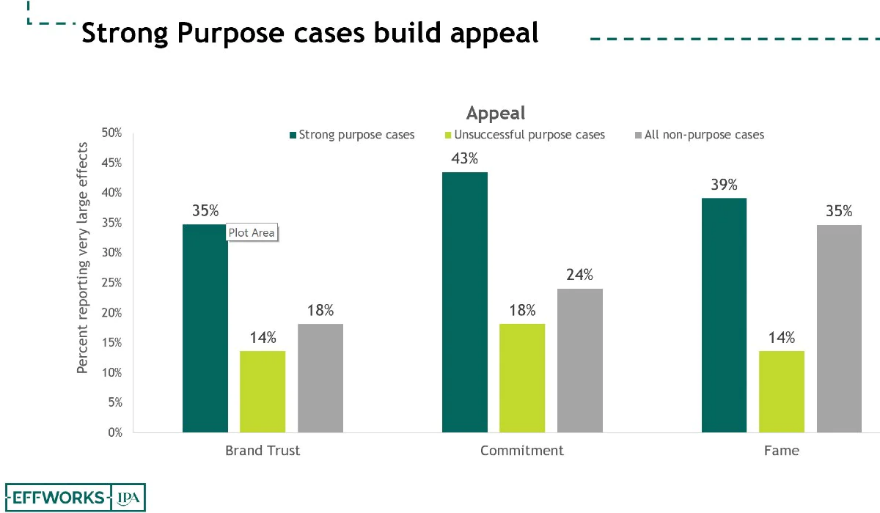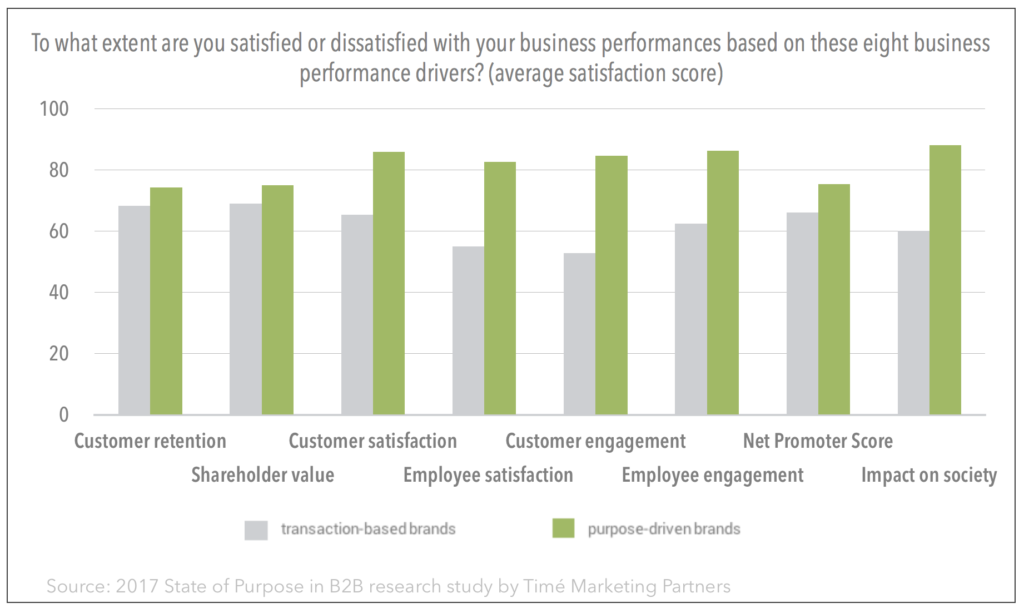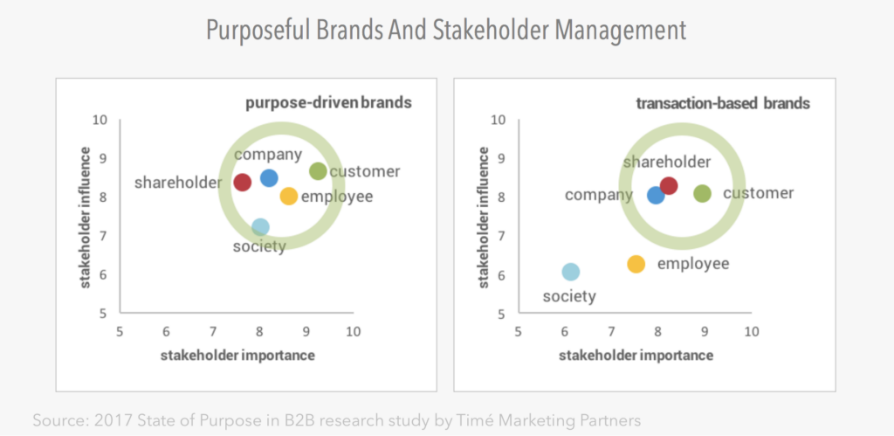The argument over Brand Purpose and its effectiveness as a brand building strategy
It has been known for a long time that marketing is not an exact science. It is impossible to define a one-size-fits-all recipe for brand building, as many factors influence the end result. What works for a new OTC drug brand will work completely differently in the luxury car category. Even the concept of an effective brand is debatable – what does it really mean and how to measure it?
Therefore, marketing is, among others, the history of evolution of various approaches to building brands – from the concept of USP (Unique Selling Proposition), through the concept of brand positioning, cultural branding, LOVEBRANDS or Byron Sharp’s concept discussing them, based on building acquisition of the widest possible audience through mental and physical accessibility. Finally, the youngest child of marketing – Brand Purpose – today has already lived to see fiery disputes among marketing experts. Since we have recently been able to follow the discussion between Peter Field and Byron Sharp, let’s give the floor to both opponents for a moment.

Byron Sharp sees Brand Purpose as a bad thing. According to the expert, the spread of this approach is set to contribute to the demise of brands and their displacement from the market by chain retailers and their own brands. Sharpe attributes the popularity of the new approach to a decline in self-esteem among marketers, who he believes are curing their deficits by seeking a higher social purpose in their daily work.
Sharp’s main substantive argument against the Brand Purpose concept is the easy copyability of Brand Purpose solutions. If all brands suddenly start caring about the environment, supporting minorities or counteracting discrimination in various fields, they will become similar and will lack distinctiveness. Interestingly, it was Byron Sharp who wrote in his concept that marketing is not so much about being different, but about being distinctive. Perhaps, then, brands will be able to find their own specific methods for realizing the Brand Purpose strategy, which at its core concern a specific set of values and needs?
Another important postulate of Byron Sharp is to unlearn marketing. He preceded the announcement of his concept with research and analysis of a large data set of the most effective brands in order to build his theses based on their conclusions. The author continues his efforts to promote such an approach to marketing – based on evidence and results analyzed over a long period of time (evidence-based marketing).
And here we come to a major barrier to the discussion of Brand Purpose. A relatively fresh and emerging approach does not always lend itself to analysis in this way. In many cases, there is not enough data collected over the long term, on an appropriate sample of cases. This is why analyses such as those presented by Peter Field are challenged and criticized by Sharpe. Peter Field analyzed the campaigns that won the IPA Effectiveness Awards. The sample included 47 campaigns based on Brand Purpose and 333 with a different approach. Methodologically, one can certainly wonder whether this is a sufficient base and whether the analysis criteria adopted are sufficiently reliable. However, returning to the belief that marketing is not entirely an exact science after all, it is worth looking at the results of Field’s analysis.
Peter Field claims that a well-enforced Brand Purpose can generate above-average business results for a brand – both in terms of new customer acquisition and market share growth.
50% of campaigns with a strong Brand Purpose produced high customer acquisition results. Campaigns without Brand Purpose achieved a similar result in 30% of cases, and those with poorly enforced Brand Purpose in just 5%. The same analysis shows that 41% of campaigns with a strong Brand Purpose deliver high market share gains, we can observe similar results in 26% of campaigns without Brand Purpose and in 0% of cases of campaigns with poorly enforced Brand Purpose. As the charts below show – strong Brand Purpose also has an impact on metrics that describe brand health – trust, engagement, popularity, and differentiation and awareness.


Byron Sharp accuses this presentation of results of manipulation – he considers separating campaigns with Brand Purpose into those with positive and negative results as a research artefact devoid of objectivity. However, it would certainly be interesting to take a closer look at these two categories of campaigns. We know without research that the Brand Purpose strategy is not the kind of black box into which we can throw our brand and easily get an effective solution. It’s a demanding and complicated approach that doesn’t always work. It would be all the more interesting to analyze what commonalities we see in successful campaigns based on Brand Purpose and what was missing in those that did not produce equally spectacular results.
There are more and more approaches to the measurement of Brand Purpose effectiveness. Another study – this time B2B, conducted on a group of over 100 CEOs and CMOs showed that brands focused on Brand Purpose (purposive brands) achieve better results than brands focused on generating sales (transaction-based brands).
¾ of the respondents to this study say they see Brand Purpose translating into growth at their company. They indicate results that are 31% higher on average when it comes to satisfaction measured on 8 key business metrics.

In addition, brands with Brand Purpose were 16% more likely to have high sales growth over 3 years and 148% more likely to have higher sales growth over the following 3 years. Net profit was twice as high for brands with Brand Purpose over 3 years and 2.2 times higher over the next 3 years.

What does the above data tell us?
First, that Brand Purpose is not the only solution available that can produce positive results. Discussions about the absolute superiority of one approach or another is fundamentally doomed to fail to reach a conclusion. So instead of pursuing zero-sum solutions, it’s worth weighing the pros and cons of using Brand Purpose in your specific case.
Secondly, that the application of Brand Purpose is demanding, and badly enforced does not forgive and brings more harm than good.
So what needs to be kept in mind when implementing a Brand Purpose strategy?
- Walk the talk – don’t lie, don’t promise too much, don’t declare before you actually do something. For a long time, marketing has been talking about creating experiences with brands, storydoing. Brand Purpose fits particularly strongly into these assumptions.
- – change for the better is a process and you need to be consistent and dedicated to your mission of action. Brand Purpose, in order to be effective, cannot be a single campaign or an additional activity “once in a blue moon”, it has to become an element of everyday life of the brand.
- Engage consumers – it’s great if you start with yourself but find ways to engage consumers and invite them to participate in achieving a specific Purpose that you share. By choosing your product or service, consumers are advocating for certain values, but perhaps they can also change their behaviors and habits.
- Be aligned with yourself – be with your Purpose as close to your field of expertise as possible. Try to take it out of your area of expertise and what you are good at. Coloring your views from day to day is rarely perceived as credible.
Does it sound like a recipe for success or rather a suggestion – it is better not to start and to go back to focusing on building physical and mental availability according to B. Sharp? In agreement with the theses of this text I should write the sacramental: “that depends”. However, at the end it is worth mentioning one more argument, which makes this concept so electrifying for marketers today.
Brand Purpose is not only a marketing concept for building brands. The condition of its effectiveness is to make it a self-reinforcing machine that works more broadly – it concerns not only the brand and its communication, but it becomes a principle of action that involves all interest groups, which translates into greater involvement of, for example, employees of a given company and broader social response, e.g. media.

Brand Purpose campaigns organically generate a stronger media response, and the implementation of the Brand Purpose approach in an organization has an impact on the satisfaction of the company’s employees. In turn, increased employee motivation can lead to what Sharp advocates, which is greater commitment to doing a “good job” of marketing and greater pride in their work. The idea is not just to have a Brand Purpose (having a Brand Purpose) but to be driven into action by it (being purpose-driven).
Why is this whole discussion generating so much excitement?
Both Byron Sharp and Peter Field use very emotional language in their statements. On the one hand it is a kind of battle to prove the superiority of approaches and a manifestation of the unquenchable desire to find a universal solution that will be objectively best in every situation. On the other hand, there is a very strong tension when we juxtapose values such as business efficiency, or making money, with social responsibility and doing good. These two sets of concepts do not go together in our minds, and sometimes they are in clear opposition – one can either be noble, which archetypically requires sacrifice and renunciation, or be successful and make a fortune. However, when we consider the phenomenon of altruism, this concept is often also connoted with benefits. We help others to feel better, to think better of ourselves, to protect a positive self-image. Money is also a kind of benefit. So maybe it’s time to disenchant the money taboo and challenge the opposition in which effectively doing good excludes the possibility of making money from it?
Sources:
https://ipa.co.uk/news/power-of-brand-purpose/
https://www.marketingweek.com/byron-sharp-purpose-death/
https://brandpurpose.nl/2017/06/25/why-brand-purpose-is-the-new-black/


